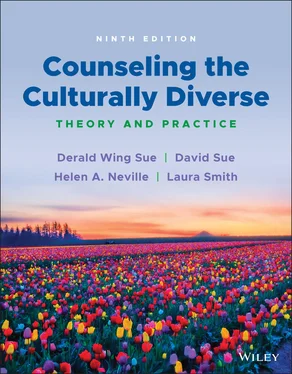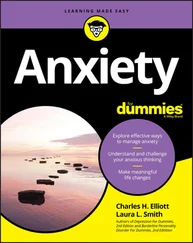First, both Jaylen and Melanie are describing common microaggressions that marginalized group members experience in their daily encounters with friends, neighbors, co‐workers, strangers, teachers, caretakers, and even those in the helping professions. Microaggressions send denigrating messages to targets that are oftentimes outside the level of conscious awareness of perpetrators. In the case of Jaylen, he is making a common observation by African Americans, that many White passengers on a bus, train, plane, or subway are disinclined to sit next to them. When Melanie is told that hiring decisions should be based on “competence and not race or gender,” she also is being sent a demeaning message. In the former case, the meta‐communication to Jaylen is that “Black men are to be avoided. They are potentially dangerous, criminals, and up to no good.” For Melanie, the statement implies she was hired to fulfill a gender quota instead of individual merit. Microaggressions carry hidden messages to targets that they are foreigners, criminals, dangerous, a threat, subhuman, less competent and capable, and lesser human beings (Sue & Spanierman, 2020).
Second, when Melanie describes feeling unwelcomed, unsafe and alienated, she is referring to the campus climate of the institution. We have already seen how microaggressions can be delivered verbally or nonverbally. Even more insidious, however, are environmental meta‐communications that are delivered to People of Color and to women. When Melanie notes that the portraits of past presidents of the university were all White men, and that the majority of new faculty were men, she is receiving an unintended environmental meta‐communication: (a) “You and your kind are not welcome here.” (b) “You will not be comfortable here.” (c) “You do not belong here.” (d) “If you choose to stay here, your advancement will be limited. You may not be promoted and tenured.” Students of color often refer to their campus climates as being alienating and exclusionary. Although many White students, for example, frequently refer to their campuses as inviting, exciting, liberating and validating, environmental micro and macroaggressions make students of color feel like they do not belong.
Third, counselors need to understand that these everyday slights are not harmless, trivial and insignificant. Microaggressions have a powerful detrimental macro impact upon targeted individuals. Reading Jaylen's story provides us with an idea of how a lifetime of microaggressions can lead to a sense of futility, hopelessness, anger, and distress. He is aware that his racialized experiences are unseen by the majority of White people, that he lives in a world of “anti‐blackness (Woods, Chronister, Grabow, Woods, & Woodlee, 2021),” that his lifeblood or psychic energies are being depleted, that he is experiencing “racial battle fatigue (Martin, 2019),” and that few believe his story (Sue, 2015).
Fourth, Jaylen recounts how when people ask him why he has a “chip” on his shoulder, his attempts to explain are dismissed, or met with disbelief. He goes further by saying “They don't want to hear.” If he is accurate in this observation, it has major implications for counseling and psychotherapy. Storytelling or listening to the stories of our clients is the primary mechanism we use to understand one another's worldviews. Many researchers and scholars have asserted that White Americans have difficulty understanding issues of racism, sexism, and heterosexismfrom socially devalued group members (Bell, 2003; Jones, 1997; Sue & Spanierman, 2020). Part of the reason is the invisibility of implicit bias, but another one is the anxiety that many feel when conversations touch upon race, racism, whiteness and white privilege (Sue, 2015). As a counselor or therapist, your ability to talk about racism and sexism comfortably and to understand how they affect the life experiences of clients are tantamount to establishing rapport. Discomfort and anxiety about the topic, and not accepting the reality and impact of bias may communicate microaggressions toward diverse clients.
Last, it is important for counselors to avoid “victim blame” and pathologizing the reactions of marginalized group members to prejudice, bias, and discrimination. Microaggressions are especially prone to these two phenomena. In the face of gender microaggressions, Melanie may be seen as overly sensitive, misreading the statements or actions of colleagues, unable to compete in a “man's world,” and that she should simply “toughen up.” In other words, she is defined as the problem, rather than her male colleagues and an institution that is male oriented and dominated. She is the one who needs to change, not the hostile and invalidating surroundings. Likewise, Jaylen's reaction can also be seen in a similar fashion. His reactions to everyday microaggressions may be attributed to also being overly sensitive and even paranoid. When he gets angry, frustrated, and resentful his responses are pathologized; he is the “angry” Black man. Someone once made this statement about schizophrenia. “Is schizophrenia a sick reaction to a healthy situation, or is it a healthy response to a sick one?” How do answers to these questions relate to Jaylen and Melanie?
CONTEMPORARY FORMS OF OPPRESSION: RACISM, SEXISM & HETEROSEXISM
Most people associate racism with blatant and overt acts of discrimination that are epitomized by hate crimes perpetrated by White Supremacist groups such as the Klan, Skinheads, Proud Boys, and Oath Keepers. Studies suggest, however, that more subtle and ambiguous forms of racism are just as detrimental (if not more so) than blatant expressions of bias because they are frequent, sometimes daily occurrences for People of Color (Sue, Capodilupo, et al., 2007; Sue & Spanierman, 2020). A similar statement can be made about sexism. Subtle sexismrepresents “unequal and unfair treatment of women that is not recognized by many people because it is perceived to be normative, and therefore does not appear unusual” (Swim, Mallett, & Stangor, 2004, p. 117). Whereas overt and covert sexismare intentional, subtle sexism is not deliberate or conscious. An example of subtle sexism is sexist language, such as the use of the pronoun he to convey universal human experience.
In many ways, subtle sexism contains many of the features that define aversive racism, a form of subtle and unintentional racism (Dovidio & Gaertner, 2000; Dovidio, Gaertner, & Pearson, 2017). Aversive racism is manifested in individuals who consciously assert egalitarian values but unconsciously hold antiminority feelings; therefore, “aversive racists consciously sympathize with victims of past injustice, support the principles of racial equality, and regard themselves as nonprejudiced. At the same time, however, they possess negative feelings and beliefs about historically disadvantaged groups, which may be unconscious” (Gaertner & Dovidio, 2006, p. 618).
Inheriting such negative feelings and beliefs about members of marginalized groups (e.g., People of Color, women, LQBTQ populations) is unavoidable and inevitable due to the socialization process in the United States (Sue, Calle, Mendez, Alsaidi, & Glaeser, 2021), where biased attitudes and stereotypes reinforce group hierarchy (Dovidio et al., 2017). Much like aversive racism, subtle sexism devalues women, dismisses their accomplishments, and limits their effectiveness in a variety of social and professional settings (Calogero & Tylka, 2014). Researchers have begun to underscore the importance of these daily experiences of subtle sexism, arguing that they are in fact harmful and need to be recognized as such (Becker & Swim, 2012; Cundiff, Zawadzki, Danube, & Shields, 2014).
Researchers have used the templates of modern forms of racism and sexism to better understand the various forms of modern heterosexism (Smith & Shin, 2014; Walls, 2008) and modern homonegativity(Morrison & Morrison, 2002). Heterosexism and antigay harassment have a long history and are currently prevalent in the United States. Studies find the following for LGBTQ persons in the workplace: (a) between 15% and 43% experience discrimination or harassment; (b) 7–41% report verbal or physical abuse or have had their workplace vandalized; and (c) 10–28% have not been promoted because they are gay or transgender (Burns & Krehely, 2011). Antigay harassment can be defined as “verbal or physical behavior that injures, interferes with, or intimidates lesbian women, gay men, and bisexual individuals” (Burn, Kadlec, & Rexler, 2005, p. 24). While antigay harassment includes comments and jokes that convey that LGBTQ individuals are pathological, abnormal, or unwelcome, it can also take more subtle forms (Burn et al., 2005). For example, blatant heterosexism would be calling a lesbian a dyke, whereas subtle heterosexism would be referring to something as gay to convey that it is stupid. For sexual minorities, hearing this remark may result in a vicarious experience of insult and invalidation (Burn et al., 2005; Marzullo & Libman, 2009). It may also encourage individuals to remain closeted, as the environment can be perceived as hostile.
Читать дальше












